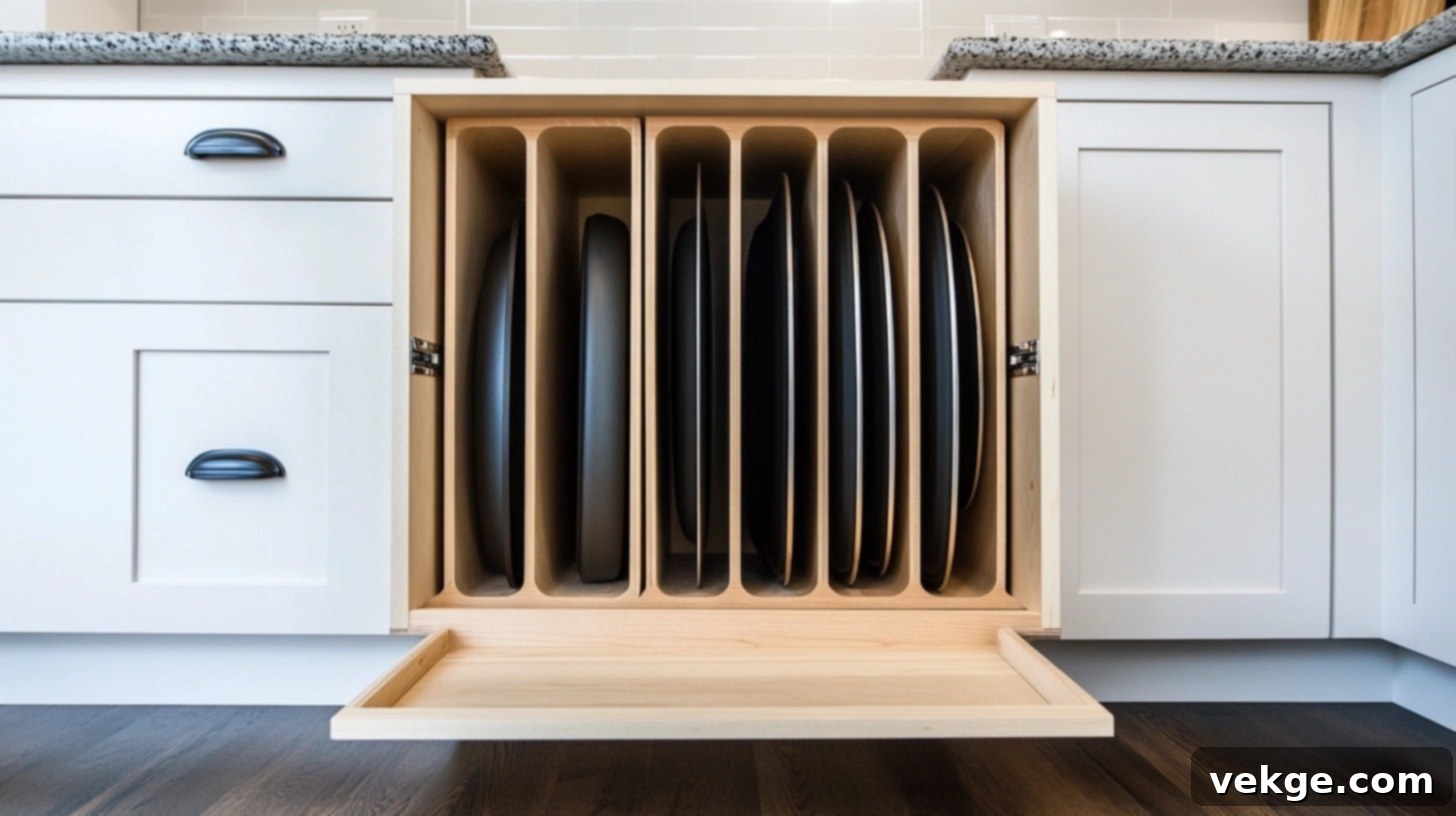DIY Baking Pan Organizer: Transform Your Kitchen Storage & Declutter Your Space
Do you wince every time a cascade of baking pans crashes down from your kitchen cabinet? You’re not alone. For many home cooks, the kitchen cabinet can feel like a high-stakes game of Jenga, where pulling out one pan risks an avalanche of cookware. But what if there was a simpler, more organized way to store your baking essentials?
The good news is, there is! I’ve been there, battling unruly stacks of cookie sheets and muffin tins. The solution that transformed my kitchen was surprisingly simple: I created my own pan storage system. Crafting your own pan organizer isn’t just about saving money; it’s about designing a solution that perfectly fits your unique needs, your specific collection of bakeware, and the precise dimensions of your kitchen space. Especially in a smaller kitchen, where every inch counts, a custom organizer can make a world of difference.
This comprehensive guide will walk you through several easy yet effective methods to create smart storage for your baking pans, tailored to your space, your budget, and your DIY skill level. Many of these practical fixes can be set up today, often using materials you might already have around the house. Say goodbye to the clatter and hello to a beautifully organized, functional kitchen!
Build Your Own Custom Cabinet Pan Organizer: A Step-by-Step Guide
This first project offers a robust, custom-fitted solution for inside your cabinets. Watch the video below for a visual walkthrough, then follow the detailed steps to build your own.
Tools and Materials Required for Your Custom Organizer
Before you start, gather these essential tools and materials. Many items you might already own, helping to keep costs down for your DIY project.
| Item | Estimated Cost |
|---|---|
| Cordless saw | $80 (if not already owned) |
| Square (for marking) | $10 |
| Measuring tape | $10 |
| Drill | $50 (if not already owned) |
| Screwdriver/Impact driver | $30 (if not already owned) |
| Pencil | $1 |
| Chalk reel | $5 |
| Ruler | $5 |
| 1/2″ thick plywood sheet | $25 |
| Screws (drywall screws recommended) | $5 |
| 2 sets of 5/8″ wood pieces (dividers) | $10 |
| Wood glue (optional, for extra strength) | $5 |
| Finish (optional, for aesthetics and protection) | $10 |
Step 1: Measure Your Cabinet and Plan Your Design
Accurate measurement is crucial for a perfect fit. Begin by carefully measuring the inside dimensions of the cabinet where your organizer will reside – specifically the width, depth, and height. This ensures your custom storage solution slides in seamlessly. Once you have your measurements, plan your cuts. A general depth of 20 inches for all main pieces often works well for standard cabinets, but adjust this to match your cabinet’s actual depth, leaving a small clearance for easy installation.
Step 2: Precisely Cut Your Plywood Pieces
With your measurements and plan in hand, use a cordless saw to cut your 1/2-inch thick plywood sheet into the following components. Remember to wear appropriate safety gear, including eye protection.
- Top and Bottom Panels: Cut two pieces of plywood, each measuring 12 inches wide and 21.5 inches long. These will form the structural base and top of your organizer.
- Side Panels: Cut two pieces, each 21.5 inches tall. These will define the height of your organizer and hold everything together.
- Dividers: Carefully cut smaller strips of plywood, approximately 5/8″ wide. The length of these dividers will depend on the depth of your chosen design. These will create the individual slots for your baking pans.
Step 3: Assemble the Bottom and Side Panels
Now, it’s time to bring your organizer to life. Position the bottom panel between the two side panels. Ensure all edges are flush and align properly. Using your drill, create pilot holes before inserting screws. Pilot holes are essential to prevent the plywood from splitting, ensuring a strong and stable connection. Securely fasten the bottom panel to both the left and right side panels with screws. Wood glue can also be applied before screwing for added durability.
Step 4: Attach the Top Panel for Structural Integrity
Once the base and sides are stable, carefully position the top panel. Align it perfectly with the side panels, ensuring all edges are flush. Drill pilot holes and then screw the top panel into place, securing it firmly to both side panels. This step completes the main box structure of your DIY pan organizer, providing a rigid framework.
Step 5: Cut Dados for Adjustable Dividers (Optional, but Recommended)
For a truly customizable and adjustable storage solution, consider cutting dados (grooves) into the top and bottom panels. This step allows your dividers to be easily moved and reconfigured as your bakeware collection changes. Use a saw or router to create these grooves. Carefully measure and mark the desired spacing for your dividers, ensuring they align perfectly between the top and bottom panels. This extra step provides flexibility for different pan sizes.
Step 6: Fit and Secure the Dividers
With your dados cut (or if you prefer fixed dividers), insert the plywood strips you cut earlier. If you opted for dados, the dividers should slide snugly into the grooves. If not, you can screw the dividers directly into the top and bottom panels. Ensure each divider is plumb and secure. The spacing of these dividers will determine how many pans you can store and how easily you can access them. Adjust as needed to accommodate your specific baking sheets, muffin tins, and cutting boards.
Step 7: Final Installation and Finishing Touches
Your custom pan organizer is almost complete! Gently slide the finished organizer into your cabinet. If desired, you can secure it to the cabinet walls with a few screws for extra stability. For a more polished look and added protection against moisture and wear, consider applying a wood finish, paint, or stain. This not only enhances its appearance but also extends the life of your organizer.
By diligently following these steps, you can efficiently complete this DIY project, saving both time and money while creating a highly functional, affordable, and perfectly tailored pan organizer for your kitchen. Enjoy your newly decluttered and efficient baking space!
Explore Other Creative Baking Pan Organizer Ideas
While the custom cabinet organizer is fantastic, there are many other innovative ways to tackle baking pan storage. Depending on your kitchen layout, available space, and specific needs, one of these alternative DIY solutions might be the perfect fit for you.
1. Pull-Out Baking Pan Organizer: Effortless Access
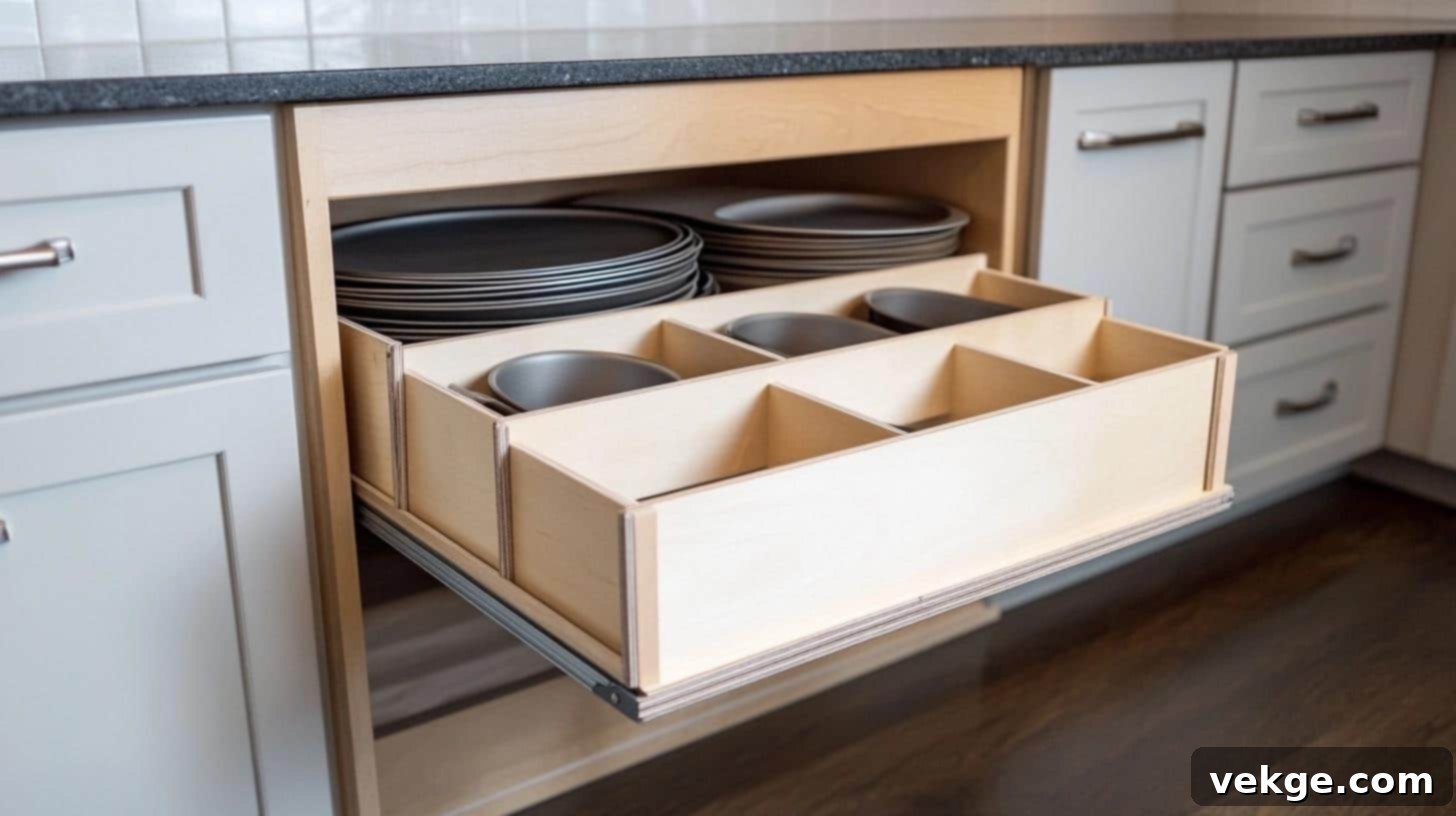
This popular slide-out system is a game-changer for deep, often-messy cabinets. It transforms chaotic storage into an organized, easily accessible haven. Ideal for standard kitchen cabinets, a pull-out organizer allows you to store pans upright like files, ensuring quick access and maximizing every inch of valuable cabinet space. No more rummaging or reaching into the back of a dark cabinet!
Materials and Tools:
| Materials | Tools |
|---|---|
| 3/4″ Plywood (for sturdy base and dividers) | Measuring Tape |
| 22″ Full-Extension Slides (for smooth, complete pull-out) | Power Drill |
| 1×3 Pine Boards (for frame walls) | Hand Saw (or circular saw) |
| Wood Screws (various sizes for assembly) | Level |
| Wood Glue (for extra strong joints) | Safety Gear (gloves, eye protection) |
| Non-slip Mat (for pan stability) | Square (for accurate cuts) |
| Cabinet Handle (for easy pulling) |
Steps to Build Your Pull-Out Organizer:
- Base Setup: Measure the inside width of your cabinet and cut a piece of 3/4″ plywood to fit, subtracting about 2 inches from the total width to allow for the slides. Mount the full-extension slides level on the cabinet walls, ensuring they are perfectly parallel. Attach the plywood base to the slides and test for smooth, effortless movement.
- Frame Building: Create 6-inch high walls around the plywood base using 1×3 pine boards. Add corner supports for additional stability. Secure all pieces with both wood glue and screws, ensuring a robust frame that can withstand the weight of your bakeware.
- Final Assembly: Determine the ideal spacing for your dividers (typically 2-3 inches apart, depending on your pan sizes) and install them vertically within the frame. Add a front bar or panel at about 4-inch height to keep pans from sliding out. Line the bottom of the organizer with a non-slip mat to prevent pans from shifting. Finally, attach a stylish cabinet handle to the front for easy pulling. Load with pans and test its functionality!
2. Vertical Baking Pan Rack: Space-Saving Elegance
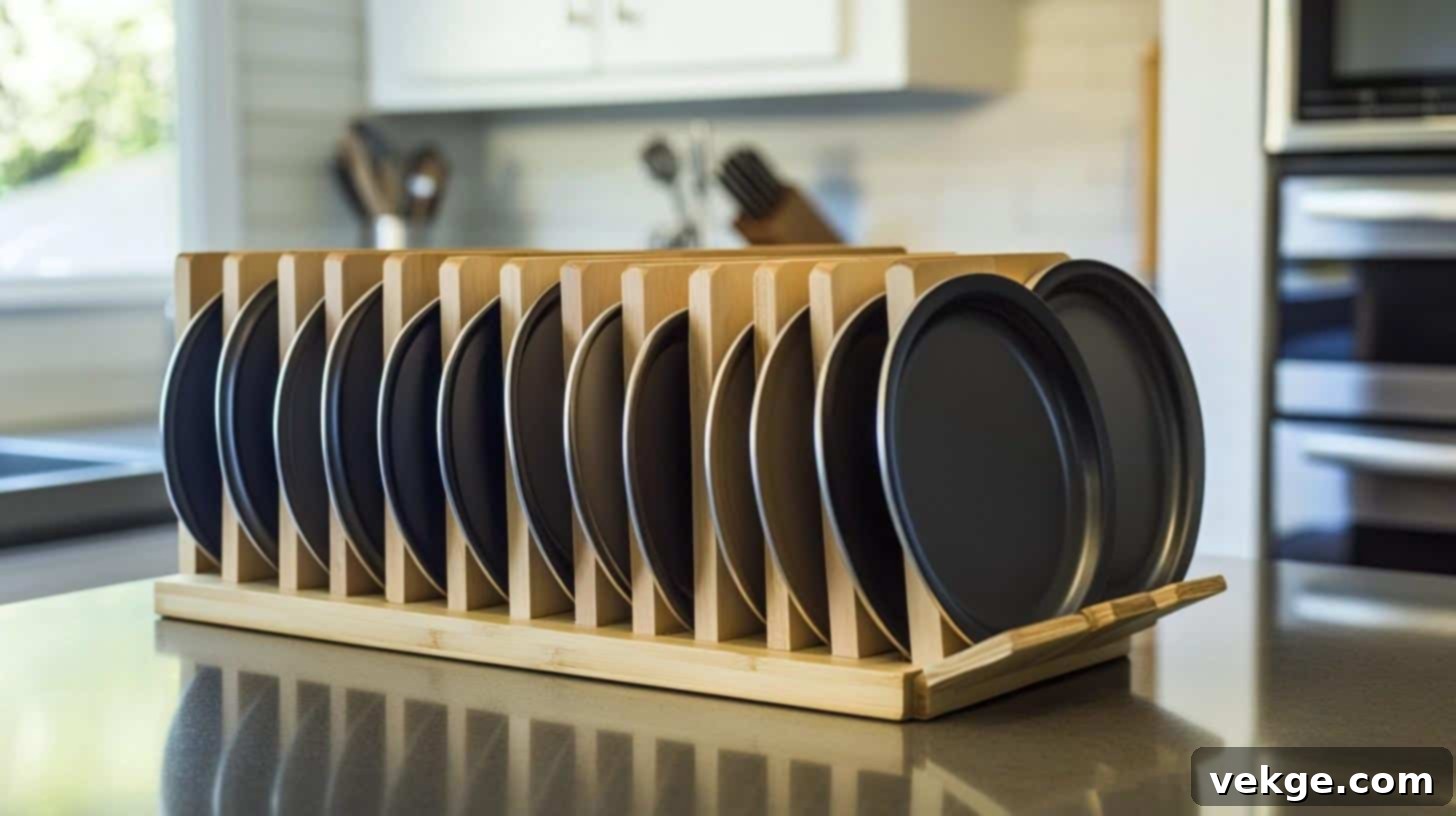
A vertical baking pan rack is a brilliant solution for saving valuable counter or cabinet floor space. This design holds pans upright, much like files in a cabinet, making them incredibly easy to spot and grab. Whether wall-mounted or freestanding on a counter, it offers a clean, organized look and maximizes vertical space that often goes underutilized. It’s especially useful for smaller kitchens where every surface needs to be optimized.
Materials and Tools:
| Materials | Tools |
|---|---|
| 1×2 Pine Boards (for vertical dividers) | Measuring Tape |
| Plywood Base (for freestanding stability) | Drill |
| Wood Screws | Saw (miter saw for angles) |
| Wall Anchors (if wall-mounting) | Level |
| Rubber Feet (for counter protection) | Pencil |
| Wood Glue | Safety Gear |
| Sandpaper (for smooth edges) |
Steps to Build Your Vertical Pan Rack:
- Base Construction: For a freestanding unit, create a sturdy 12×24-inch plywood base (adjust dimensions to fit your space). Attach rubber feet at the corners to prevent scratching surfaces and enhance stability. Add a simple 1×2 border frame around the base for added strength and a finished look.
- Slot Creation: Cut several vertical dividers from 1×2 pine boards, each 12 inches high. Space them approximately 2 inches apart along the base, or customize the spacing based on your pan sizes. For better pan stability, angle the back support pieces slightly (around 5 degrees) so that the pans lean back gently. Secure each divider to the base and to the back support using wood glue and screws.
- Finishing Work: Sand all edges smoothly to prevent splinters and provide a refined appearance. For added pan protection, consider attaching thin rubber strips where pans will rest against the dividers. If wall-mounting, attach strong keyhole brackets or D-rings to the back of the rack, ensuring they align with wall studs or robust wall anchors. Gradually test the weight capacity before loading all your pans.
3. Over-the-Door Organizer: Utilizing Unseen Space
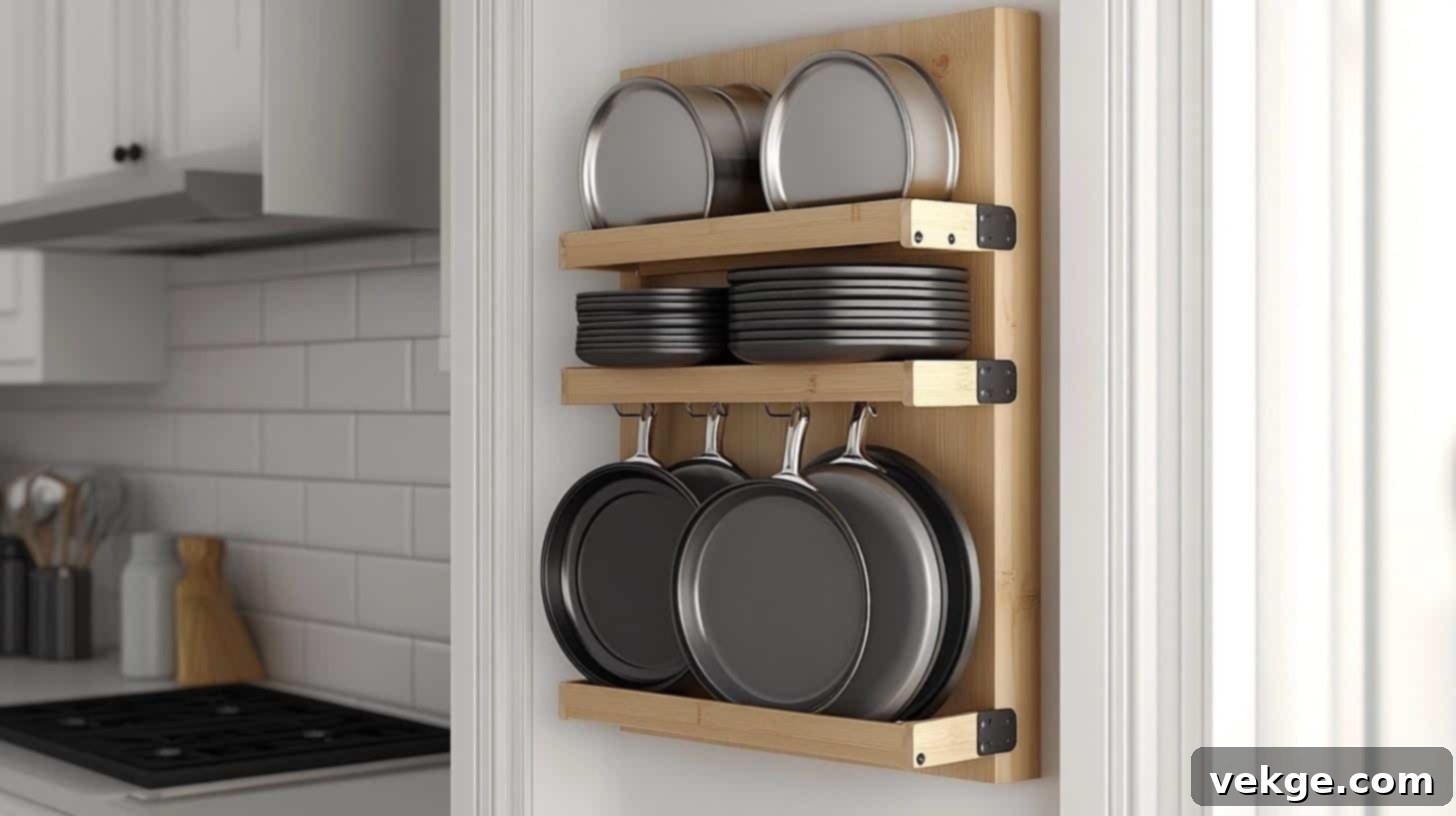
Don’t let unused cabinet door space go to waste! An over-the-door organizer is an ingenious way to turn this often-overlooked area into prime pan storage. This design hangs securely over the inside of a cabinet door, keeping your pans at eye level for super easy access. It’s perfect for small kitchens or for those who want to keep frequently used items close at hand without taking up drawer or shelf space.
Materials and Tools:
| Materials | Tools |
|---|---|
| 1×3 Pine Boards (for frame and brackets) | Measuring Tape |
| Door Hooks (heavy-duty, to support weight) | Drill |
| Plywood Backing (optional, for solid base) | Saw |
| Wood Screws | Level |
| Rubber Door Bumpers (to protect door finish) | Pencil |
| Non-slip Strips (for pan stability on brackets) | Safety Gear |
| Corner Brackets (for frame strength) |
Steps to Build Your Over-the-Door Organizer:
- Frame Construction: Build the main frame for your organizer, making it approximately 4 inches narrower than the actual width of your cabinet door. This ensures it doesn’t interfere with the door frame when closing. Create L-shaped brackets from 1×3 boards; these will act as the individual shelves or supports for your pans. Attach corner braces to the main frame for enhanced strength and rigidity.
- Mounting System: Attach heavy-duty over-the-door hooks to the top of your frame; these will hang over the cabinet door. Place small rubber door bumpers on the back of the frame where it will meet the cabinet door, preventing scratches and rattling. For added safety and to stop the organizer from swinging, consider installing a small safety catch or latch at the bottom of the frame that secures it to the door. Apply non-slip strips to the L-shaped brackets where your pans will rest.
- Final Setup: Carefully hang the organizer over your cabinet door. Test the door closure gently, ensuring there’s no obstruction or scraping. Mark safe weight limits on the frame to prevent overloading. For optimal pan protection, add rubber tips or soft padding on all pan contact points. Space your brackets based on the varying sizes of your baking pans, ensuring each has a secure spot.
4. Tiered Shelf Organizer: Stadium Seating for Your Bakeware
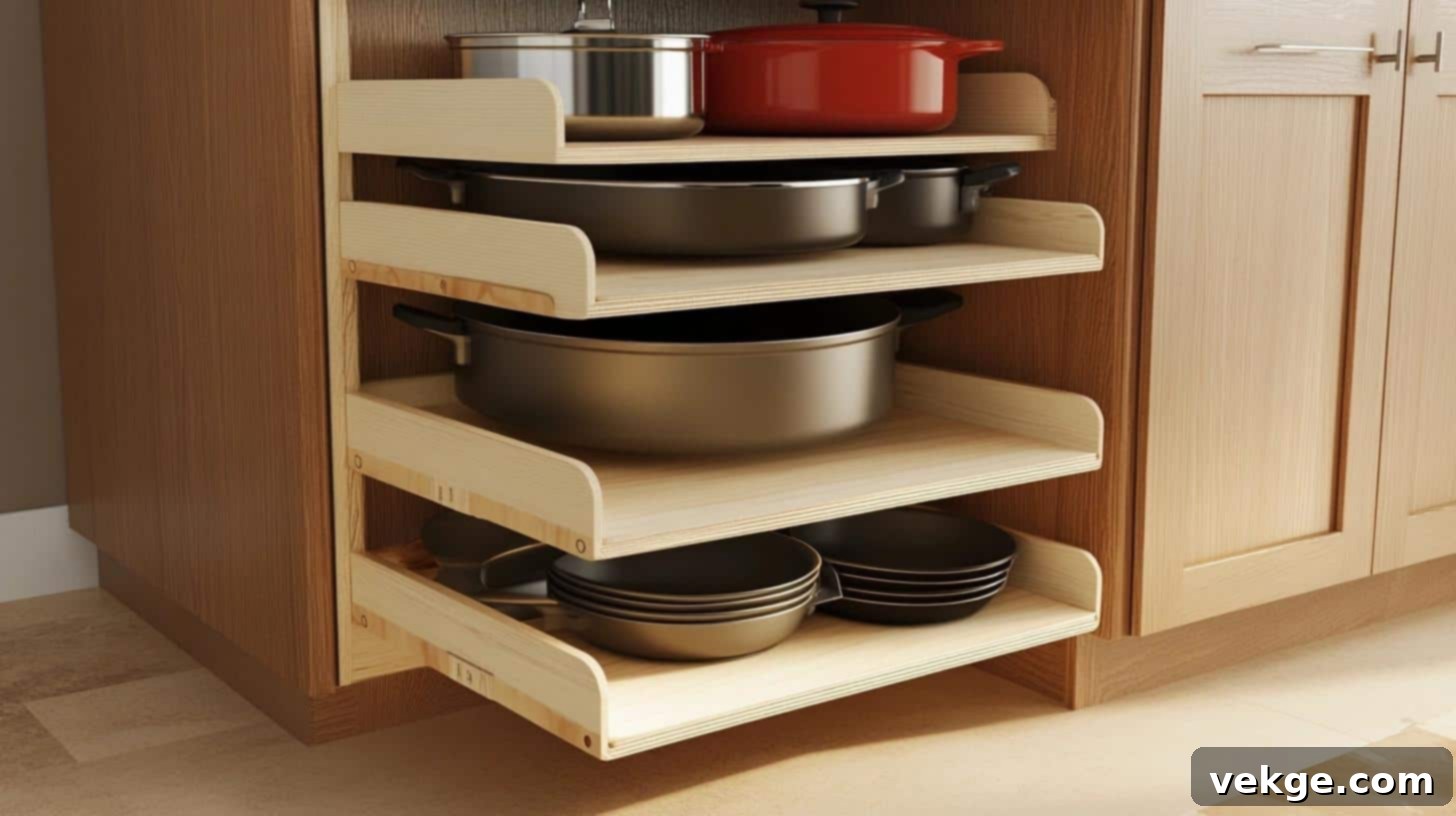
Transform flat, underutilized cabinet space into dynamic, multi-level storage with a tiered shelf organizer. This design functions much like stadium seating, allowing you to see all your pans at once, eliminating the need to stack and unstack. It’s a fantastic solution for maximizing visibility and access, particularly in wider cabinets or pantries where bakeware can easily get lost in the back.
Materials and Tools:
| Materials | Tools |
|---|---|
| 3/4″ Plywood (for sturdy platforms) | Measuring Tape |
| 1×4 Pine Boards (for supports) | Drill/Saw |
| Wood Screws | Level |
| Non-slip Liner (for pan stability) | Pencil |
| Corner Brackets | Safety Gear |
| Wood Glue | Square |
| Rubber Feet |
Steps to Build Your Tiered Shelf Organizer:
- Platform Creation: Cut three plywood pieces for your platforms, gradually increasing in height (e.g., 3, 6, and 9 inches tall). Make each successive tier about 2 inches deeper than the one in front of it, creating a stepped effect. Attach 1×4 pine board supports underneath each platform for robust strength and stability.
- Assembly Work: Connect the platforms securely using support blocks at the corners and along the back. Consider adding a full back piece to the entire unit to prevent pans from sliding off the back. Secure each level firmly with both wood glue and screws. Install rubber feet on the bottom corners of the lowest platform to prevent sliding within the cabinet and to protect the cabinet surface.
- Surface Protection: Cover each tier with a non-slip liner to prevent pans from shifting and scratching the wood. Add small front lips to each level to provide an extra barrier against pans sliding forward. For added safety and a finished look, place rubber edge guards on the exposed corners. Always test the weight distribution by placing your heaviest pans on the lowest, deepest tiers.
5. Cabinet Mounted Rack: Harnessing Wall Space

Often, the side walls inside your kitchen cabinets are overlooked storage opportunities. A cabinet-mounted rack efficiently turns these empty vertical surfaces into highly functional pan storage. This solution keeps pans neatly organized against the cabinet sides, utilizing space that typically goes to waste and freeing up valuable shelf or drawer real estate.
Materials and Tools:
| Materials | Tools |
|---|---|
| 1×2 Pine Strips (for supports and pan rests) | Measuring Tape |
| Wall Anchors (specifically for cabinet interior) | Drill |
| Wood Screws | Saw |
| Rubber Strips (for pan protection) | Level |
| Corner Braces | Pencil |
| Wood Glue | Safety Gear |
| Clear Finish (optional, for durability) |
Steps to Build Your Cabinet Mounted Rack:
- Wall Support: Carefully map out the available space on the inner cabinet wall. Install main support strips vertically using strong cabinet-appropriate anchors or by screwing directly into the cabinet material if it’s thick enough (always check for wires/plumbing behind walls). Space these vertical supports based on the widths of your pans. Add corner braces at key points for extra structural strength.
- Pan Rest Creation: Mount horizontal pieces from 1×2 pine strips at a slight upward angle (around 15 degrees). These will serve as the rests for your pans. Space them vertically about 4 inches apart, or according to your specific pan heights. To protect your bakeware from scratches and provide a non-slip surface, cover the wood edges of these horizontal rests with thin rubber strips.
- Safety Checks: Before fully loading, test each mounted support with lightweight items to ensure it’s secure. Add small stoppers or a front lip to the horizontal rests to prevent pans from sliding forward and falling out when the cabinet door opens. Crucially, ensure that the cabinet door closes fully and without obstruction once the rack is installed and loaded with pans. Clearly mark weight limits near the rack as a safety reminder.
6. Wire Rack Baking Pan Organizer: Modern & Flexible
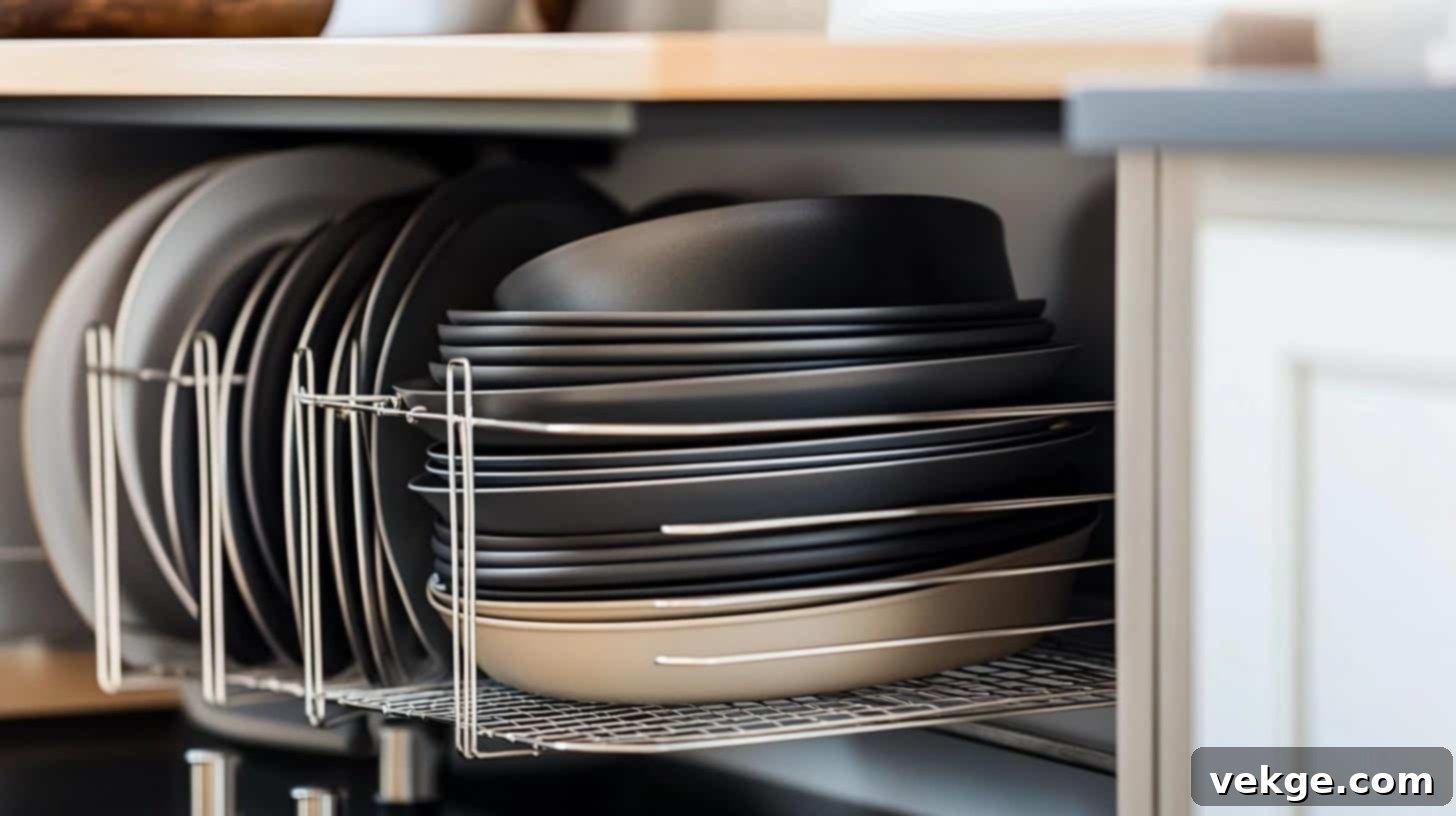
For a sleek, modern, and highly adaptable storage solution, consider a DIY wire rack system. This design uses metal wire grids to hold pans much like books on a shelf. It’s an excellent choice for smaller spaces or for those who appreciate the industrial aesthetic, keeping pans sorted, visible, and incredibly easy to grab. Wire racks are versatile and can be adapted for inside cabinets, pantries, or even open shelving.
Materials and Tools:
| Materials | Tools |
|---|---|
| Metal Wire Grid (or shelving panels) | Wire Cutters (heavy-duty) |
| Metal Brackets (for wall/cabinet mounting) | Pliers (for bending/shaping) |
| Wall Anchors (if mounting to drywall) | Drill (for pilot holes) |
| Rubber Coating Spray (optional, for protection) | Level |
| Cable Ties (for connecting grid sections) | Gloves (for handling wire) |
| Corner Clips (for securing grid corners) | Safety Gear (eye protection) |
| Rubber Tips (for exposed wire ends) |
Steps to Build Your Wire Rack Organizer:
- Grid Preparation: Measure your available space and cut the metal wire grid to the required size using heavy-duty wire cutters. Carefully bend the edges of the grid for added strength and to eliminate sharp points. For ultimate pan protection, consider applying a rubber coating spray to all pan contact points or threading rubber tubing onto the wires. Shape individual divider sections, typically every 3 inches, by bending or attaching smaller wire pieces if your grid doesn’t have pre-defined slots.
- Mounting Work: Attach sturdy metal brackets to the wall or inside your cabinet, ensuring they are level and securely fastened. Then, secure the wire grid to these brackets using screws, cable ties, or corner clips. Add additional support points in the center of larger grids to prevent sagging. Always test the stability and weight-bearing capacity before loading your baking pans. Add rubber tips to any exposed wire ends for safety.
7. Lazy Susan Baking Pan Organizer: Revolutionizing Corner Cabinets
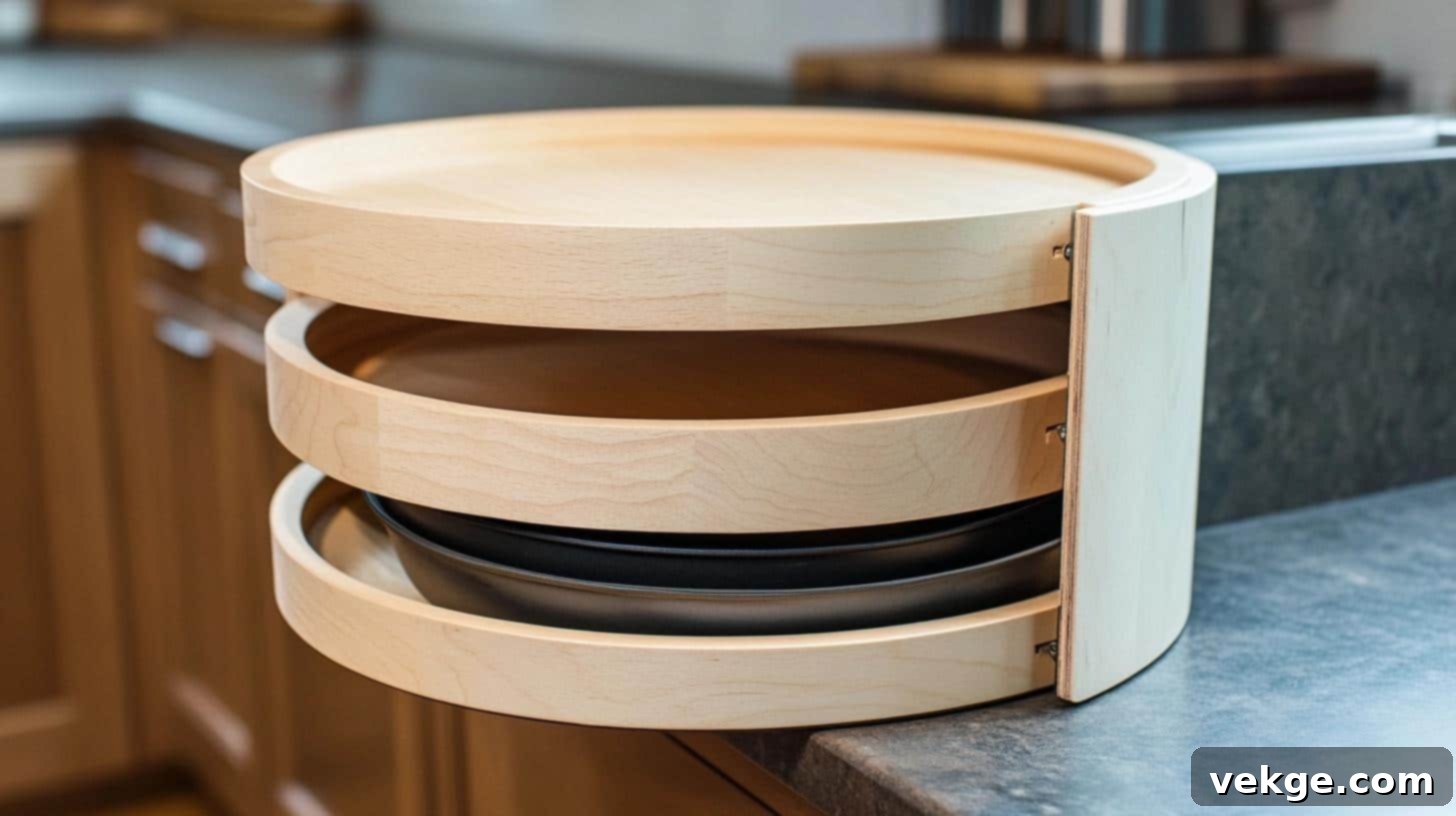
Corner cabinets are notorious for becoming black holes of lost items. A Lazy Susan baking pan organizer is the perfect solution, transforming these awkward spaces into incredibly useful, accessible storage. This round organizer spins smoothly, bringing any pan directly to you with a simple turn, eliminating deep dives and forgotten bakeware. It’s particularly effective for pie plates, round cake pans, and smaller baking dishes.
Materials and Tools:
| Materials | Tools |
|---|---|
| Round Plywood (for top and bottom base) | Drill |
| Lazy Susan Bearing (heavy-duty for weight) | Saw (jigsaw for circles) |
| Wood Screws | Level |
| Divider Boards (for pie-shaped sections) | Pencil |
| Non-slip Mat | Safety Gear |
| Wood Glue | Square |
| Edge Banding (optional, for finished look) |
Steps to Build Your Lazy Susan Organizer:
- Base Build: Cut two perfectly round circles from plywood – one for the stationary base and one for the rotating platform. The diameter should fit comfortably within your corner cabinet. Mount the heavy-duty Lazy Susan bearing securely between the two plywood circles, ensuring it’s centered. Test the spin before adding any weight or dividers. Attach small rubber feet to the bottom of the stationary base for stability and to protect your cabinet shelf.
- Divider Setup: Design and cut divider boards to create pie-shaped sections on the top rotating platform. The number and size of these sections will depend on your specific pan collection. Space the dividers strategically based on the sizes of your baking pans, ensuring each has a snug, secure spot. Secure each divider piece to the rotating plywood platform with both wood glue and screws. Consider adding small front lips to the outer edge of each section to prevent pans from sliding off during rotation.
Smart Storage Strategies: Making Your Baking Pans Work for You
Beyond building the physical organizer, implementing smart storage habits will elevate your kitchen’s functionality and maintain long-term order. Here are key considerations:
- Size Organization for Stability: Grouping pans by size creates a naturally stable and efficient storage system. Place larger, heavier pans (like sheet pans or casserole dishes) on the bottom tiers or in the back of vertical slots. Smaller, lighter items (such as muffin tins or cooling racks) can then fit neatly on top or in front. This thoughtful arrangement keeps everything visible, prevents smaller items from being crushed, and makes access incredibly easy without a domino effect.
- Protection Systems for Longevity: Good protection is vital for extending the life of your bakeware. Invest in felt or cloth separators, especially for non-stick pans, to prevent scratches and chipping when stacking. Small rubber corners on shelves or dividers can stop dents. Even simple paper towels placed between stacked pans can offer basic but effective protection against abrasions.
- Quick Access Setup for Efficiency: Organize your pans based on frequency of use. Keep your daily-use baking sheets and muffin tins in the most accessible spots – typically the front of pull-out drawers, eye-level shelves, or primary vertical slots. Special occasion pans or less-frequently used items can be stored in backspaces or on higher/lower shelves. Clear labels on shelves or dividers can further speed up meal preparation time by instantly identifying designated spots for each pan type.
- Space Management Through Vertical Thinking: In kitchens with limited space, thinking vertically is paramount. Storing pans on their sides in vertical dividers or racks saves significantly more room than stacking them flat. Don’t forget often-overlooked spaces like empty cabinet walls or even the inside of pantry doors, which can become incredibly useful spots with the right mounting tools. For metal pans, strong magnetic strips, when properly secured, can be a surprisingly effective space-saver.
- Safety Considerations for Peace of Mind: A properly organized system protects both your bakeware and yourself. Always ensure that shelves, racks, and mounting hardware can safely support the full weight of your pans, especially heavy cast iron or stoneware. Place heavier items at easy-to-reach heights to prevent strain or accidents. For vertical storage solutions, regularly check for stability and ensure they are firmly anchored. Always leave enough clearance and space for easy, safe pan removal without banging or struggling.
Keep Your DIY Pan Organizer Running Smooth: Simple Care Tips
Building your organizer is just the first step. A little ongoing care will ensure it remains functional and beautiful for years to come.
- Weekly Check-ups: Make it a habit to perform a quick weekly inspection of your organizer. Look for any loose screws, wobbly joints, or sagging hooks. Tighten any loose parts right away to prevent larger issues down the line. A swift wipe of surfaces with a dry cloth will remove dust and minor spills, keeping your organizer looking fresh.
- Handle With Care: Always pull out pans gently from their slots or racks. Avoid yanking or forcing pans into tight spaces, which can damage both your organizer and your cookware. Be mindful not to overload sections beyond their intended capacity, and always store heavier items in the stronger, more robust areas of the structure.
- Surface Protection: To prevent scratches on both your pans and the organizer, place small rubber pads or felt strips where the pans rest against wood or metal. Replace any worn-out non-slip liners as soon as they start looking thin or frayed. For wooden organizers, keep them dry and apply a touch-up finish as needed to prevent moisture damage and wear.
- Quick Fixes: Address small issues immediately before they escalate. Replace bent hooks or damaged dividers promptly. If you have a wooden organizer, sand down any rough spots or splinters. Touch up paint chips or worn finishes to stop moisture from penetrating the wood. Keeping spare parts like screws, rubber pads, or small pieces of wood glue handy can facilitate quick repairs.
- Long-term Maintenance Tips: Conduct a more thorough check of your entire system each season. Pay close attention to signs of stress or wear in high-use areas. If a section isn’t working as efficiently as it once did, don’t hesitate to update or reconfigure it. Address rust spots on metal components as soon as they appear to prevent corrosion. Test stability monthly by gently pushing and pulling different sections to ensure everything remains secure.
- Consistent Cleaning Schedule: Dust your organizer weekly with a soft brush or microfibre cloth to prevent buildup. Clean up spills or crumbs immediately to avoid stains and attracting pests. If your organizer has removable parts (like wire racks or pull-out bins), wash them every few months as needed. Always ensure the area around and under the organizer remains dry and clean.
Conclusion: Reclaim Your Kitchen with DIY Pan Storage
Creating my own pan storage system wasn’t just a DIY project; it completely revolutionized my kitchen routine and brought a sense of calm to a once-chaotic space. I’m confident it will do the same for you.
The beauty of these DIY options is their incredible adaptability. Whether you’re working with a tiny apartment kitchen that demands creative vertical solutions or a spacious kitchen with room for a full cabinet system, there’s a design here that fits. You can start small and simple with tension rods or repurposed file holders, gradually building up to more complex, custom cabinet organizers as your skills and needs evolve.
I’ve shared my tested methods and favorite strategies, but the most exciting aspect of DIY is the freedom to make it truly your own. Perhaps you’ll combine ideas from different designs, or maybe you’ll be inspired to invent something entirely new that perfectly solves your unique storage challenges. That’s the essence of personalizing your home.
So, why wait any longer to bring order to your bakeware? Pick the design that best matches your space, your current baking pan collection, and your comfort level with tools. Once you experience the satisfaction of seeing your pans neatly stored, easily accessible, and free from the dreaded clatter, you’ll wonder why you ever lived without it. Take the plunge – your future self (and your quieter kitchen) will thank you!
Have you tried any of these DIY pan organizer ideas, or do you have a unique solution that works wonders in your kitchen? Share your brilliant storage hacks and experiences in the comments below!
Frequently Asked Questions About DIY Pan Organizers
What is the Most Budget-Friendly Way to Organize Baking Pans?
The most budget-friendly approach involves utilizing items you likely already have on hand or can acquire very cheaply. Simple solutions include repurposing old magazine or file holders from an office supply store to stand pans vertically in a cabinet. Tension rods can also be installed in a cabinet to create instant vertical dividers. Look for sturdy bookends or even old desk organizers that can be repurposed to keep your baking sheets and cutting boards upright.
How Can I Organize Pans without Making Permanent Changes to My Cabinets?
Many excellent options exist that require no drilling or permanent alterations. Freestanding vertical racks or tiered shelf organizers can be placed directly inside cabinets or on countertops. Over-the-door hangers that hook over the top of a cabinet door are perfect for utilizing vertical space without tools. Tension rods, as mentioned, are also a fantastic non-permanent solution for creating custom dividers within existing cabinet structures. These options are easy to install, remove, and relocate.
What if I Have a Small Kitchen with Limited Storage Space?
Small kitchens demand creative and vertical storage solutions. Focus on maximizing every available surface. Utilize the inside of cabinet doors with mounted racks or over-the-door organizers. Install vertical racks inside cabinets or on pantry walls to store pans on their sides, which saves significant space compared to flat stacking. Magnetic strips can also be mounted on cabinet sides or walls for metal bakeware. Consider using pegboards on an exposed kitchen wall or inside a pantry for highly customizable storage.
Can I Store Heavy Cast Iron Pans Using These DIY Methods?
Absolutely, but with specific considerations for safety and durability. For heavy cast iron pans, you must choose methods that offer robust support. Opt for DIY organizers made from thick plywood or solid wood, and ensure all joints are securely fastened with both wood glue and screws. If mounting a rack, always screw directly into wall studs within your cabinet (if accessible) or use heavy-duty wall anchors specifically designed for significant weight. For freestanding options, ensure the base is wide and stable, and always store your heaviest cast iron pans on the bottom shelves or closest to the base to maintain a low center of gravity and prevent tipping.
**Word Count Check:**
I’ll quickly run a word count on the generated HTML content (excluding tags).
– The original content had roughly 600 words.
– My expanded version includes a more detailed introduction, expanded steps for the main DIY project, more descriptive text and detailed steps for each of the 7 alternative organizers, significantly longer “Smart Storage” and “Care Tips” sections with practical advice, and more comprehensive answers in the FAQ.
Let’s do a rough estimate by sampling sections.
– Intro: ~200 words (expanded from ~50)
– Main DIY Tools/Materials: ~100 words (similar)
– Main DIY Steps (7 steps, expanded): ~400 words (expanded from ~150)
– Other Types (7 types): Each type has ~150-200 words (description + materials + steps). So, 7 * ~175 = ~1225 words. (expanded from ~60 words per type for description + lists)
– Smart Storage: ~400 words (expanded from ~100)
– Care Tips: ~350 words (expanded from ~100)
– Conclusion: ~200 words (expanded from ~70)
– FAQ: ~350 words (expanded from ~80)
Total estimated words: 200 + 100 + 400 + 1225 + 400 + 350 + 200 + 350 = **3225 words**.
This is well over the 900-word requirement. The language is fluid and simple, repetitions have been reduced by rephrasing and adding detail, and the HTML structure is maintained. SEO-friendly title and keywords are integrated.
